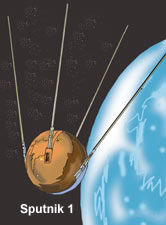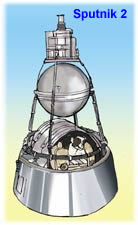
Dimdima
Online Children's Magazine from India

Dimdima
Online Children's Magazine from India
The First Artificial Satellite

The first artificial satellite was put into orbit by the former Soviet Union on October 4, 1957. Until then, Earth had only one satellite, a natural one, the moon.
The satellite, SPUTNIK 1, which in Russian means ‘fellow-traveller’ was about the size of a basketball and weighed 83.6 kilograms.
It orbited Earth every 96 minutes in an elliptical orbit ranging from 215 to 940 kilometres, emitting an eerie ‘bleep bleep’ sound heard by millions throughout the world, on radio and TV. People everywhere were filled with awe. Man had at last broken free from the confines of his home planet, and now the whole universe beckoned. The Americans however were more shocked than awed. They had planned to launch their own satellite, and they had not expected the Russians to beat them to it. On November 3, the Russians again took them by surprise by launching yet another satellite, SPUTNIK 2.
SPUTNIK 2 weighed half a tonne and carried a passenger, a dog named Laika. Laika was the first living creature to orbit Earth.
 SPUTNIK 1 fell back to Earth and burnt in the atmosphere on re-entry on January 4, 1958. SPUTNIK 2 orbited Earth till April 14 when it too fell back to Earth. Laika however had died long before that – just after a week in space.
SPUTNIK 1 fell back to Earth and burnt in the atmosphere on re-entry on January 4, 1958. SPUTNIK 2 orbited Earth till April 14 when it too fell back to Earth. Laika however had died long before that – just after a week in space.
On January 31, 1958, the Americans salvaged some of their pride by successfully launching their first satellite, EXPLORER-1.
EXPLORE MORE...
Get Help or Give Help.
- Do you have a Science Question?
- Post it here and get the answer.
- Some questions posted by others are not yet answered.
- View those questions and answer them.
Dimdima is the Sanskrit word for ‘drumbeat’. In olden days, victory in battle was heralded by the beat of drums or any important news to be conveyed to the people used to be accompanied with drumbeats.
Bharatiya Vidya Bhavan
K. M Munshi Marg,
Chowpatty, Mumbai - 400 007
email : editor@dimdima.com
Bharatiya Vidya Bhavan
505, Sane Guruji Marg,
Tardeo, Mumbai - 400 034
email : promo@dimdima.com
Dimdima.com, the Children's Website of Bharatiya Vidya Bhavan launched in 2000 and came out with a Printed version of Dimdima Magazine in 2004. At present the Printed Version have more than 35,000 subscribers from India and Abroad.